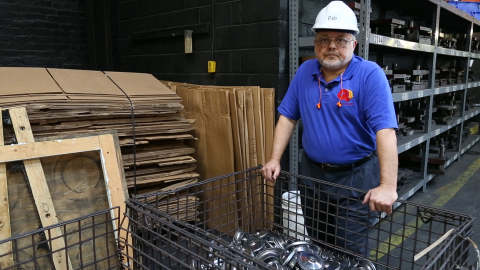Oak Ridge National Laboratory, with support from the U.S. Department of Energy, teamed up with Queen City Forging, the U.S. Forging Industry, and Infrared Heating Technologies to develop a rapid-infrared heating furnace to produce aluminum turbochargers.
As president of Queen City Forging, a metal components supplier for more than 120 years, he was struggling to remain competitive. In 2004, CEO Rob Mayer drew a majority of his revenue from manufacturing metal parts such as horseshoes and sewing machine rocker arms–but business was declining and his machinery was getting old.
The company began producing a small batch of aluminum turbocharger impellers, which increase the efficiency and power output of internal combustion engines. Aluminum is less expensive than traditional titanium impellers but convection oven pre-heating processes were not producing a quality product that could stand up to the harsh conditions of diesel engines.
“That’s really when I started being concerned with metallurgical properties,” said Mayer. “I wanted to know how we could achieve the superior properties that forging could offer.”
Mayer learned about a new infrared heating technology through the Forging Industry Association (FIA). It was developed by the Energy Department’s Oak Ridge National Laboratory (ORNL) through Office of Energy Efficiency and Renewable Energy (EERE) funding. The technology refines grain size of aluminum by processing it in a special infrared oven that allows for rapid heating and cooling. This led to an overall improvement in aluminum strength, hardness, and fatigue life.
With support from EERE, ORNL teamed up with Queen City Forging, FIA, and Infrared Heating Technologies to develop a rapid infrared heating furnace to produce aluminum turbochargers.
ORNL researchers tested the infrared furnace against traditional heating methods at the Queen City Forging plant in Cincinnati. On the very first try, the infrared oven produced 50 aluminum impellers that exceeded customer requirements. More importantly, as researchers increased the aluminum production volume, the new infrared oven shortened pre-heating time for aluminum billets from four hours to 15 minutes. Working with the entire supply chain, the turbocharger line took less than two years to deploy and now makes up half of Queen City Forging’s gross earnings.
The new heating technology has quadrupled Queen City Forging’s production, decreased energy consumption by 70%, and reduced Mayer’s maintenance costs. With hundreds of thousands of impellers produced per year, the company recently announced plans to expand its manufacturing plant.
“I’d guess I’d have to say it saved our bacon in one way,” said Mayer.
Amped Up! Magazine is the Office of Energy Efficiency and Renewable Energy’s publication that highlights breaking technologies and achievements in renewable power, energy efficiency and sustainable transportation that influence global change toward a clean energy economy.



